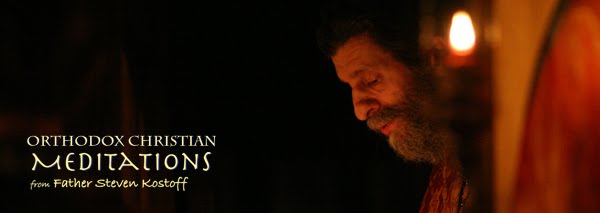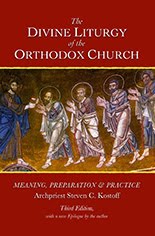Dear Parish Faithful,
Christmas is actually the Feast of the Nativity/Birth of the Lord Jesus Christ, which is actually the Feast of the Incarnation - of the Word becoming flesh (JN. 1:14). As we draw closer to December 25, I would like to provide everyone with a modest-sized anthology of excerpts from the Fathers of the Church and contemporary theologians on precisely that great Mystery. These texts will also include the Mystery of the Motherhood of the Virgin Mary; for it is impossible to speak of the Incarnation without including the Mother of the Incarnate One. The Virgin Mary is bound to her Son (and God) in a manner wholly unique to her incredible vocation. Se is the Mother of the Son of God who received His flesh from her. We should marvel all the more, when we realize that she was chosen for this vocation from all eternity. These texts are meant to be deeply-pondered over (as the Theotokos pondered these things in her own heart) in the hope that we continue to contemplate the Mystery "hidden before the ages" with a sense of awe and prayerful thanksgiving. And perhaps these texts will assist us in focusing our dispersed minds and hearts that are driven to distraction by the other attractions of the Season, on the Incarnate Lord.
This first text from St. Nicholas Cabasilas (+14th c.) has become something of a "classic" as it beautifully balances the divine initiative and the free response of the Virgin Mary:
The Incarnation of the Word was not only the work of Father, Son and Spirit - the first consenting, the second descending, and the third overshadowing - but it was also the work
of the will and faith of the Virgin. Without the three divine persons this design could not have been set in motion; but likewise the plan could not have been carried into effect
without the consent and faith of the all-pure Virgin. Only after teaching and persuading her does God make her his Mother and receive from her the flesh which she consciously
wills to offer him. Just as he was conceived by his own free choice, so in the same way she became his Mother voluntarily and with her free consent.
Here is an excerpt from a homily by Metropolitan Philaret of Moscow, a very prominent hierarch from 19th c. Russia. Met. Philaret was known and respected not only as an excellent theologian, but also as a genuine ascetic, and an outstanding preacher. In fact, he may be best known for his superb homilies in which deep thought and a kind of exalted style of expression combine to impart a sense of the majesty and holiness of God in His activity toward the world. The following short text is actually a small excerpt from a homily on the Feast of the Annunciation. But the Incarnation actually occurs when the Son of God is conceived in the womb of the Virgin Mary. Thus this passage bears witness to the essential role that the Mother of God fulfills in the Incarnation, very similar to what I shared yesterday from St. Nicholas Cabasilas.
During the days of the creation of the world, when God uttered his living and mighty words: Let there be ... the Creator's words brought creatures into existence. But on
the day, unique in the existence of the world, when Holy Mary uttered her humble and obedient Let it be, I would hardly dare to express what took place then - the word
of the creature caused the Creator to descend into the world. God uttered his word here also: You will conceive in your womb and bear a son ... he will be great ... and he will reign over the house of Jacob forever. But again that which is divine and incomprehensible occurs - the word of God itself defers its action, allowing itself to be
delayed by the word of Mary: How can this be? Her humble Let it be was necessary for the realization of God's mighty Let it be. What secret power is thus contained
in these simple words: Behold, I am the handmaid of the Lord; let it be to me according to your will - that it produces an effect so extraordinary? This marvelous power
is Mary's pure and perfect self-dedication to God, a dedication of her will, of her thought, of her soul, of her entire being, of all her faculties, of all her actions, of all her
hopes and expectations.
The following is from St. Cyril of Alexandria (+444), the great patriarch of that thriving cosmopolitan city, and perhaps the Church's greatest "Christologian" (if such a term actually exists). Or, we could say that St. Cyril is one of the Church's greatest theologians who wrote with exceptional penetration, depth and insight about the Person of Christ. In the heat of a very polemical atmosphere, in which St. Cyril had to defend the Church's understanding of the Person of Christ against the inadequate, misleading, and even heretical teachings of one Nestorius, St. Cyril was able to explain the union of the divine and human natures in the one Person of Christ in such a convincing manner, that his approach is to this day accepted as the criterion for Orthodoxy. He did this by defending the term Theotokos for the Virgin Mary when that term was attacked and rejected by Nestorius. If the Virgin Mary gave birth to the Second Person of the Trinity - the eternal Word and Son of the Father - then she must be granted the title of Theotokos, for God was born of her in the flesh that He received from her.
His most complete treatment of an Orthodox understanding of the Person of Christ (Christology) may be in his major work known as On the Unity of Christ. Below is just one excerpt from a book overflowing with endless insights into the Mystery of the Incarnation. Notice how St. Cyril endlessly develops the paradox of God becoming man, building on and extending the Apostle Paul's pregnant phrase: "He was rich but became poor for our sake, so that we might be enriched by his poverty" (II COR. 8:9) This became one of the Fathers most cherished methods for explaining the wonder of the Incarnation.
Christ is understood as the Heavenly Man, not as if He brought down His flesh from on high and out of heaven, but because the Word who is God came down from
out of heaven and entered our likeness, that is to say submitted to birth from a woman according to the flesh, while ever remaining what he was, that is one from on
high, from heaven, superior to all things as God even with the flesh. This is what the divine John says about him somewhere: "He who comes from above is above
all" (JN. 3:31). He remained Lord of all things even when he came, for the economy, in the form of a slave, and this is why the mystery of Christ is truly wonderful.
... Indeed the mystery of Christ runs the risk of being disbelieved precisely because it is so incredibly wonderful. For God was in humanity. He who was above all
creation was in our human condition; the invisible one was made visible in the flesh; he who if from the heavens and from on high was in the likeness of earthly
things; the immaterial one could be touched; he who is free in his own nature came in the form of a slave; he who blesses all creation became accursed; he who is all
righteousness was numbered among transgressors; life itself came in the appearance of death. All this followed because the body which tasted death belonged to no
other but to him who is the Son by nature. Can you find any fault in any of this ...
On the Unity of Christ, p. 61)








